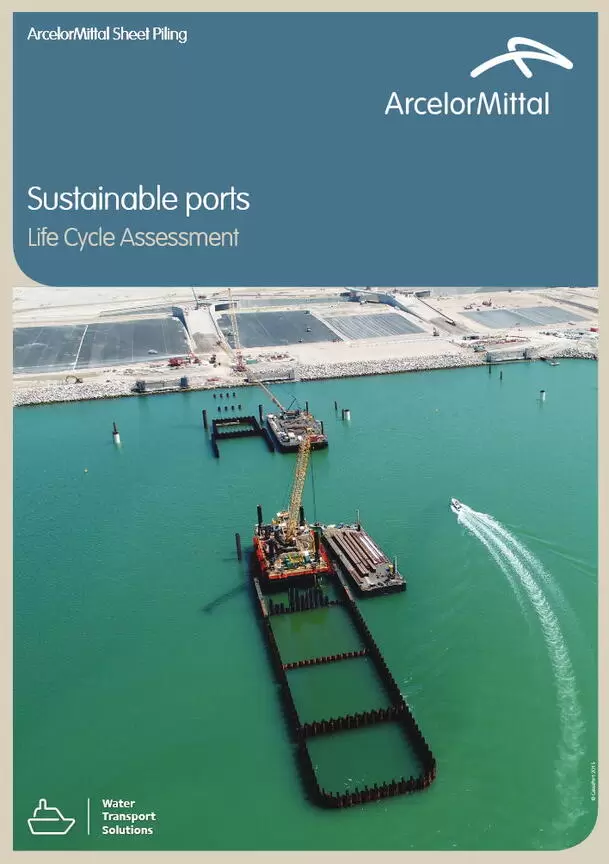Port structures: status quo and future needs
Ports have been faced with quite a number of challenges in recent years. On the one hand, sea traffic has steadily increased and modern vessels are getting bigger. On the other hand, our planet is struggling with greenhouse gas emissions. Ports need to expand with new berths being built, but how can we achieve these goals without harming the environment?
Before building a new structure, examining the possibility of extending the service life of existing structures makes sense. This is the best option from an environmental point of view, but older structures typically require retrofitting. Hence, only an economic and environmental analysis can help the owner make an informed decision. When it comes to increasing the dredge level to welcome vessels with higher drafts or when existing structures are close to failure, building a new quay wall may be the sole viable option.
Solutions
byLife Cycle Assessment of a quay wall: building sustainable ports
Conscious of the importance of reducing the carbon footprint in civil engineering by supplying durable products with reduced environmental impacts, ArcelorMittal is looking into the eco-design of its product range of steel sheet piles. In 2019, ArcelorMittal assigned a Belgian engineering firm with the task of designing and comparing technical and financial aspects of three different alternatives to build a 200-metre-long quay wall for a new cruise ship terminal in a Belgian port. The new brochure, Sustainable Ports – Life Cycle Assessment, focusses on the environmental impact of the two most cost-effective solutions resulting from this study and on their Global Warming Potential (GWP).
Identifying the most efficient solutions for a modern quay wall
ArcelorMittal appointed Tractebel, an independent Belgian consulting engineering firm, to analyse this multifaceted topic. The engineers proposed focussing on three key indicators: technical, financial, and environmental criteria. Their task consisted of comparing three different technical solutions for those indicators. The selected structure for analysis was a cruise ship terminal capable of accommodating the largest cruise ships. It would be built in a Belgian port, with a draught of 13 m in typical soil and load conditions for a Belgian port.
This brochure focuses on the environmental impact of the two most cost-effective solutions resulting from this study - a steel sheet pile wall and a concrete diaphragm wall - and on their Global Warming Potential (GWP).
Life Cycle Analysis and Global Warming Potential as sustainability indicators
The Life Cycle Analysis (LCA) of the two most cost-efficient solutions was based on the bill of quantities prepared by Tractebel, performed by ArcelorMittal’s R&D department, and peer-reviewed by an independent panel of experts.
The objective was to compare the Total Life Cycle Cost of the steel sheet pile and the concrete diaphragm solutions, including the burdens or benefits of the end-of-life phase (the dismantling and recycling of the building elements without considering reuse).
For this type of application, an LCA is a reasonably fair and transparent method to compare different solutions and suppliers. Although not required by ISO and EN standards, an LCA is more accurate and realistic when it uses specific Environmental Product Declarations (EPD) from the producers rather than generic data from databases.
Construction cost (including design) was chosen as the principal key indicator for the choice of solution. The key environmental indicator analysed in this case was the carbon footprint expressed as the GWP. Its impact for the base scenario is summarised in the graph for a 200-metre-long wall. This indicator can be included in a scheme to choose the most sustainable solution, referring to the most economically advantageous tender.
The winner is…the EcoSheetPile™ solution!
In this study for the construction of a 200-metre-long quay wall, the steel sheet pile wall made with EcoSheetPile™ (sheet piles produced from 100% recycled steel in an Electric Arc Furnace) offers a 44% lower carbon footprint compared to the diaphragm wall. This corresponds to a saving of 559 tonnes of CO2-eq.
In its quest to further improve the eco-design of steel sheet piles, ArcelorMittal uses renewable energy in the secondary production route (Electric Arc Furnace), thus further reducing the GWP by around 30% (based on the EcoSheetPile™ Plus EPD).
The EcoSheetPile™ Plus range is part of ArcelorMittal's 'XCarb® Recycled and renewably produced' brand.
Download the brochure to learn more about the goals, scope and assumptions, methodology, detailed results, sensibility analysis, conclusions, and limitations of this study.
Text:
ArcelorMittal Sheet Piling
Constructalia
Images:
Courtesy of Port of Rønne
ArcelorMittal Sheet Piling




























